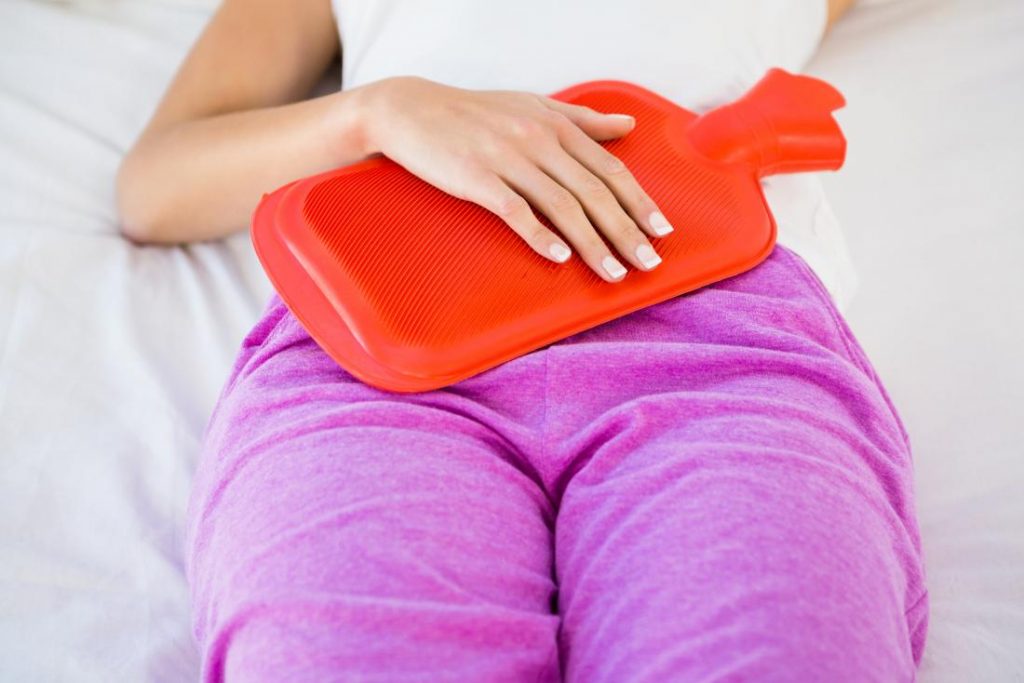Period pain is also known as menstrual cramps. Dysmenorrhea is the medical term of period pain. Many women have experienced menstrual cramps during their periods. Period pain is as painful as muscle cramp in the abdomen (tummy ) which can extend to the back and thighs too. The intensity of the pain varies from woman to woman and the level of prostaglandin. This lower abdominal ( tummy ) pain is very common. These pains can affect women day to day activities.
Periods pain can be of two types :-

- Primary – These pain are not caused by any medical conditions. Generally, during the period when a girl starts her first menstrual cycle, she experiences some lower abdominal pain. In this type, the pain lasts for the 1st to 4th days of their periods.
- Secondary – your pains are caused by underlying medical conditions. secondary dysmenorrhea starts in the 30s or 40s of women. They can experience pain when they are not on their periods and multiple times too.
Causes of Periods pain :-

The main and common cause of period pain is the muscular wall contraction of the womb. There is continuous tightening and contracting of the muscular wall of the womb but it is mild, that is why it is not felt. But during periods, it contracts more vigorously. This contraction sheds the womb lining as a part of the period. During the contraction, there is a temporary cut down of blood supply in the uterus and due to the lack of Oxygen chemicals are produced from the tissues of the uterus that triggers the pain. Prostaglandin is also one kind of chemical that is produced. This chemical increases the contraction more.
There are some underlying medical conditions that causes period pain :-
These medical conditions affect mostly 30 to 45 age women.
Endometriosis :-

This is a condition where the cell is implanted in other places like ovaries, fallopian tubes etc.and not in the uterus. This is an inflammatory disease.
Fibroids :-

these are benign tumors that are t non cancerous tumors that grow in the uterus.
Pelvic inflammatory disease :-

In this, the upper genital tract (fallopian tubes, ovaries, and upper part of the uterus) is affected by bacteria. This is also an inflammatory disease.
Adenomyosis :-

The tissue lining the uterus starts growing into the muscular wall of the womb.
Period pain can also be caused by the contraceptive devices :-

Intrauterine devices (IUDs) are a type of contraceptive device that is inserted in the uterus. It is made up of copper and plastic. In the first few months of insertion, it causes severe pain during periods.
Self-help

To get relief from the pain you can try the following tips :-
- Use a heating pad or hot water bottle, place it on your abdomen to reduce the pain.
- If you smoke, stop smoking this will reduce the risk of Periods pain.
- slightly massage your lower abdominal and the back in a circular motion to get relief from the pain.
- exercise can help you with the pain. It is hard to exercise in the period as you feel lazy but walking and being active during the period can help you with the period of pain.
- Wear loose-fitting clothes during this time.
- Transcutaneous electrical nerve stimulation ( TENS) – a machine that is a small battery-operated device that sends mild electrical current to your abdomen that relieves your pain.
- Take painkillers if the pain is severe like ibuprofen and aspirin.
Consult a gynaecologist –
- If you experience severe pain when you are not on your periods.
- You have heavy bleeding and worse pain during the periods
- When pain is not relief from medication.







